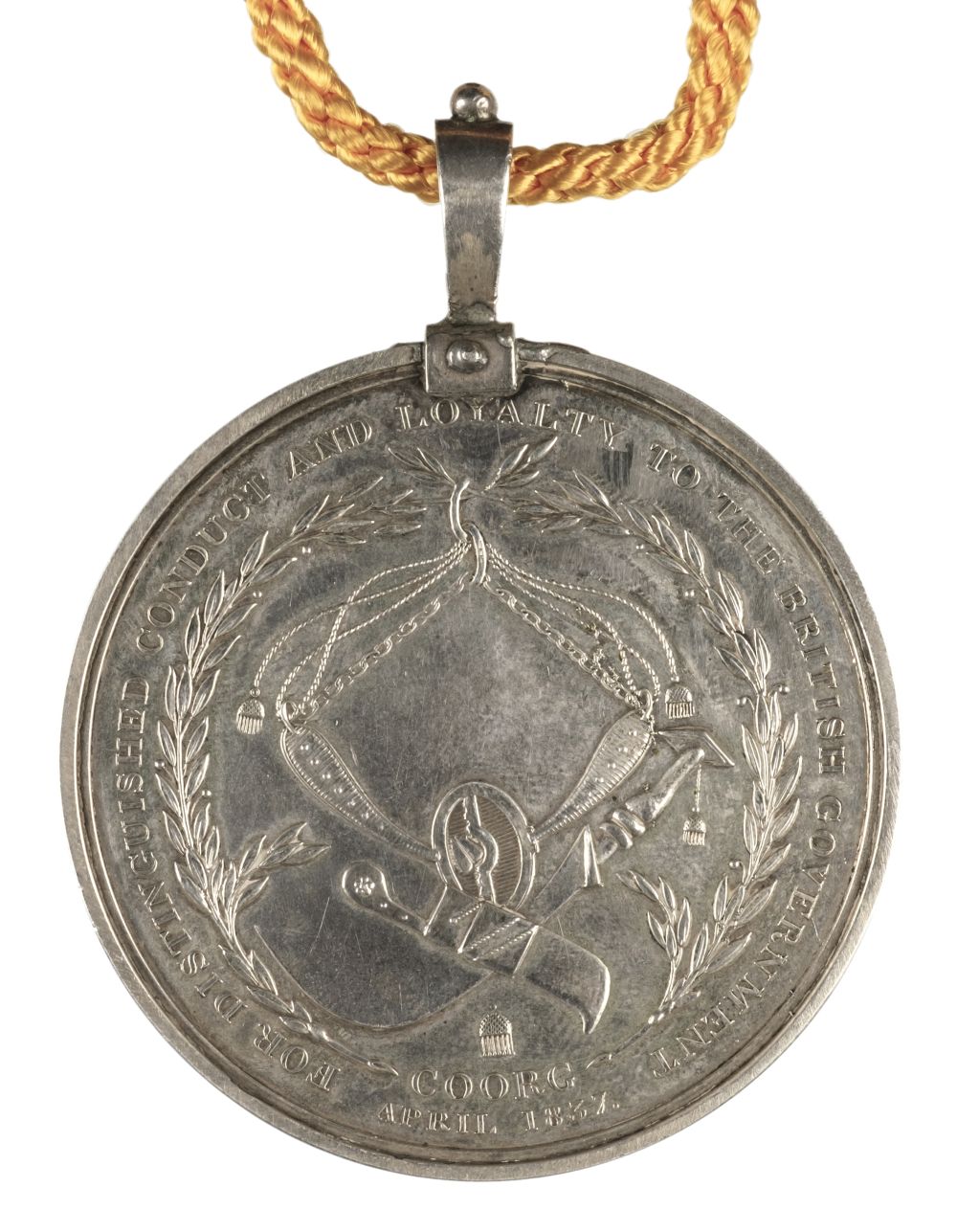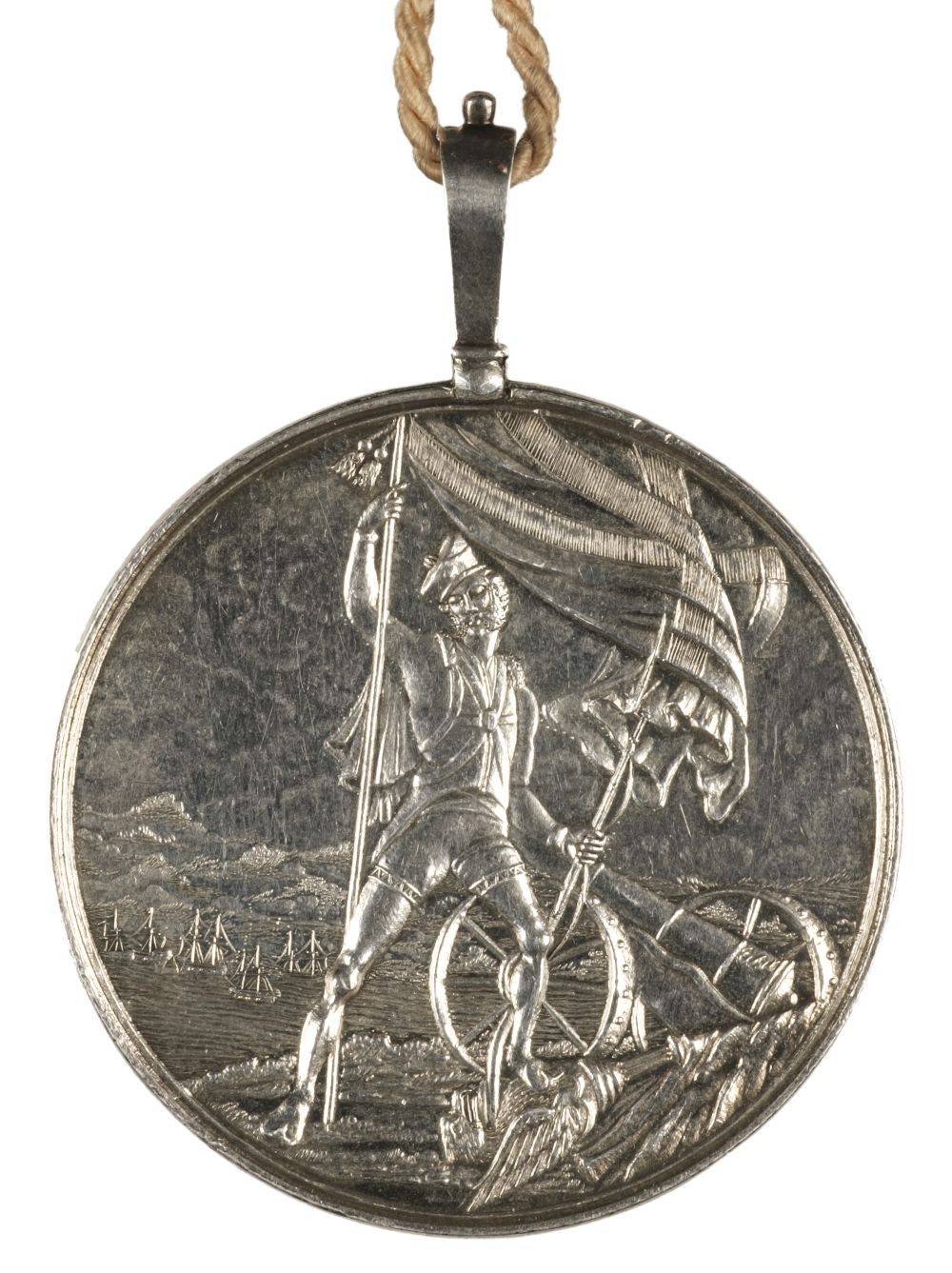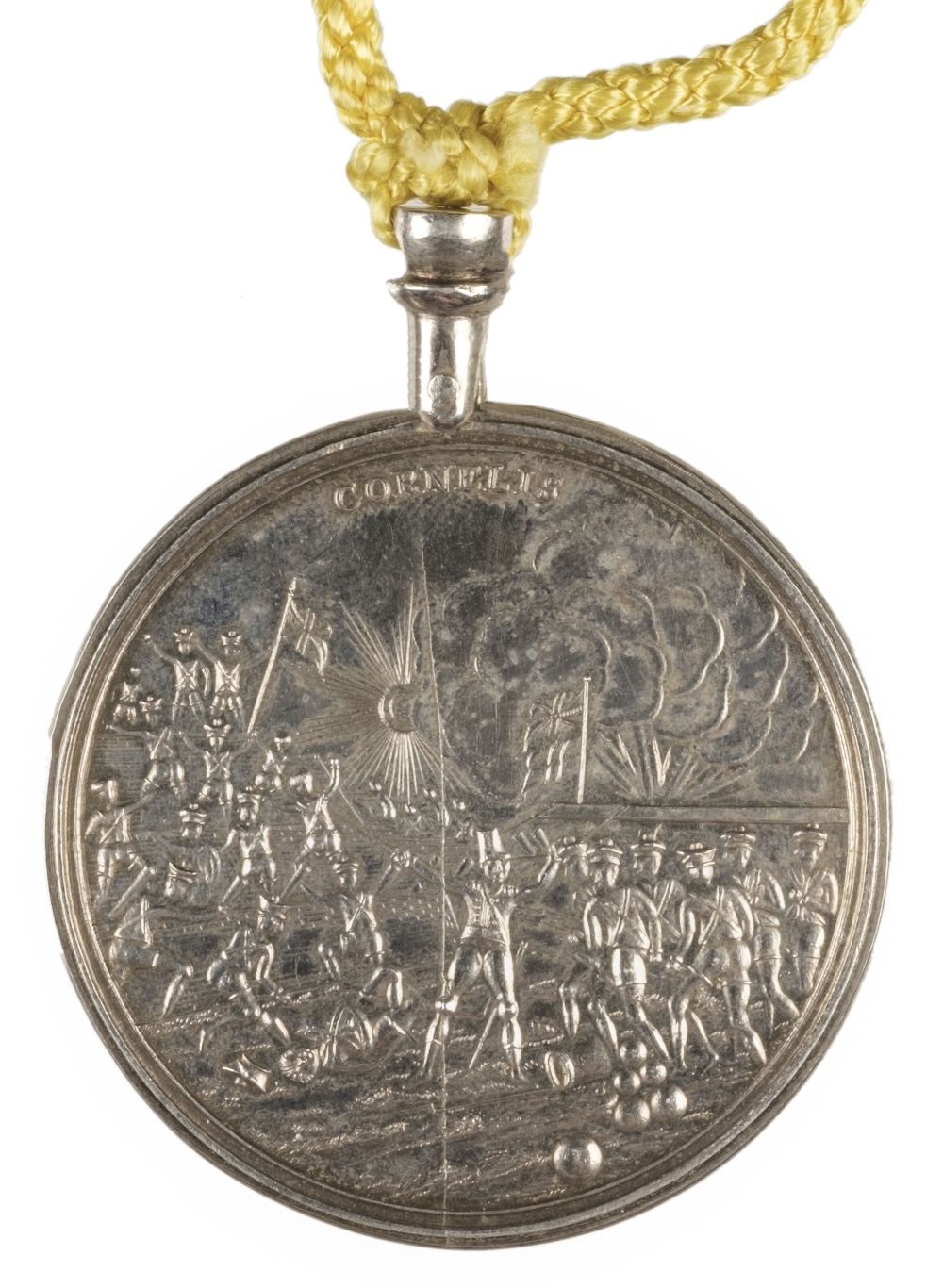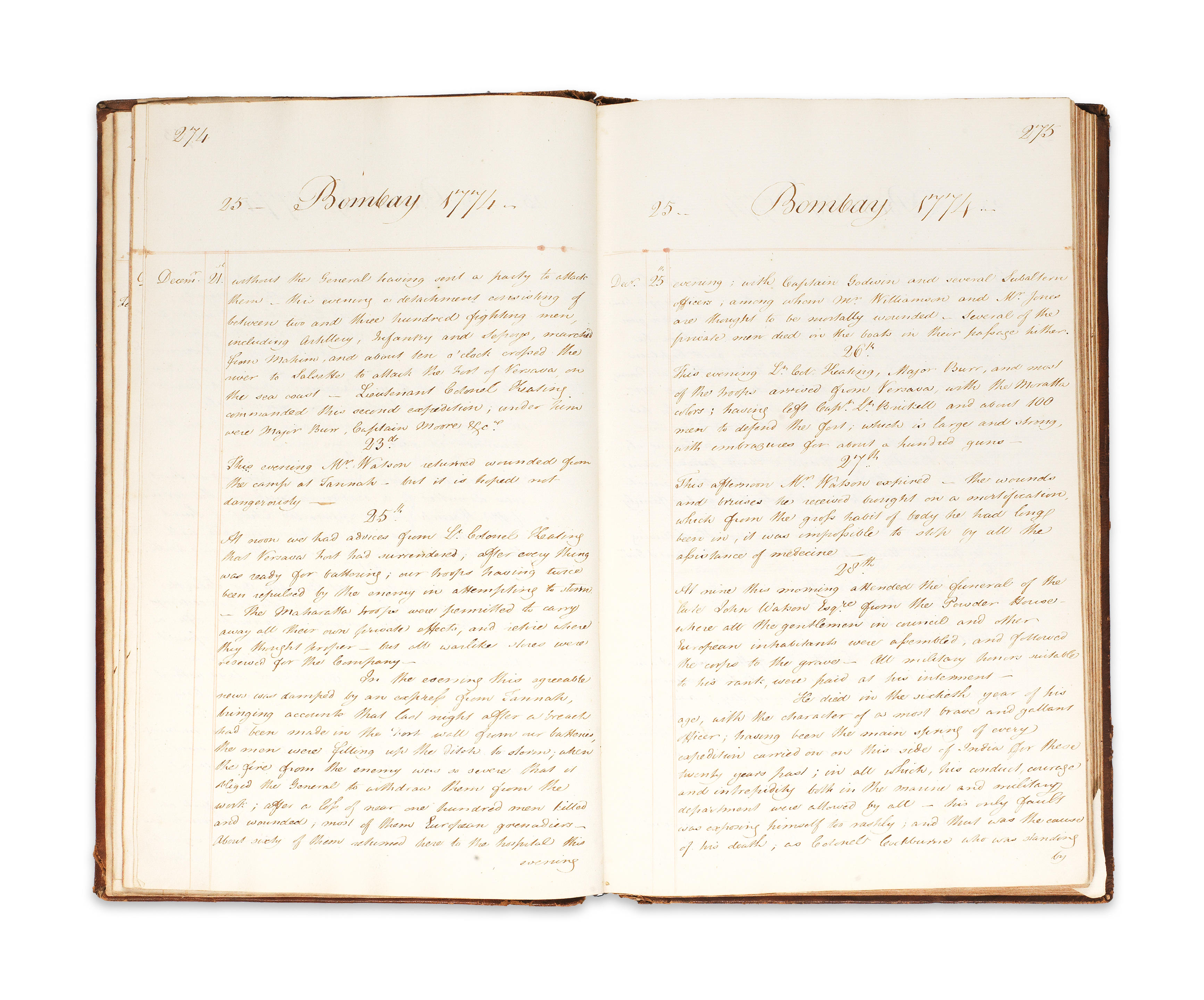The Honourable East India Company’s Medal for Seringapatam awarded to Major General C. Farran, who was General Baird’s Brigade Major during the storming of the city; in an earlier campaign he had led a Forlorn Hope into a booby-trapped breach in the walls of a mountain fortress and survived an explosion that killed 28 men Honourable East India Company Medal for Seringapatam 1799, silver, 48mm, Soho Mint, fitted with a substantial silver-rimmed glazed case and solid silver swivel suspension, the case engraved ‘Captn. Chars. Farran Bde Major 1st Brigade’, with the original riband fitted with a top silver bar with a further loop for suspension and with a riband buckle engraved ‘Seringapatam 4th May 1799’, with spare buckle and riband, in damaged contemporary fitted red leather case, some tarnish discolouration around the edges, otherwise extremely fine £2000-2600 Footnote Charles Farran was born in 1768 and arrived in India in 1790. He immediately joined the army of General Sir William Medows, the Governor of Madras, who had just invaded Mysore. Medows was struggling to match the superior military skill of Tipu Sultan, the renowned Ruler of Mysore. Farran first saw action in the battle of Coverapatam. He was in Major Gowdie’s Brigade in the battle near Bangalore on 6 March 1791 and at the siege and capture of the city, and fought in several sharp little actions as Tipu sought to repel the British attempts to take Bangalore. After the Siege and Capture of Bangalore, he participated in the capture of several Mysorean forts. Lord Cornwallis, the Governor-General, superseded Medows and launched an offensive designed to capture Tipu’s capital, the fortified city of Seringapatam. Farran was in the thick of it, especially the major battle at Arakore on 15 May 1791. Tipu was defeated and forced back into the safety of Seringapatam’s mighty walls, but Cornwallis was almost out of supplies and chose to retreat back to Company territory. Farran joined Cornwallis’s second invasion of Mysore in 1791-92. He helped to capture Severndroog and other strong fortresses before joining the attack on Tipu’s fortified camp under the walls of Seringapatam on the night of 6 February 1792. The Sultan was decisively beaten and sued for peace. Farran was promoted to Lieutenant in 1792, aged 24. After the end of the Third Mysore War, Farran was employed in expeditions against several troublesome chieftains who had caused difficulties for the H.E.I.C. in the northern Circars. When the news reached India that Britain was at war with Revolutionary France, he eagerly volunteered to join the siege of Pondicherry. In August 1794 the H.E.I.C. seconded Farran to the ‘Hyderabad Contingent’, troops which the Nizam of Hyderabad provided as an ally of the Company. He became Adjutant of the 28th Native Infantry, and spent the next year fighting the Nizam’s enemies, notably the Rachore insurgents. He was an important leader during the attack on their camp outside the city, then the assault on the Pettah wall surrounding Rachore, and finally at the siege and storming of the hill-top fortress itself. As the attacking troops swept through the breach in the fortress wall created by the siege artillery, there was an enormous explosion as the insurgents detonated a massive concealed gunpowder bomb. Twenty-eight men were killed, but Farran, though caught in the blast, survived. The 28th Native Infantry was thanked by the Madras and Supreme Governments for their part in this campaign. Farran then joined the pursuit of Gookeley, a marauding Mahratta chief who had invaded the Dooab. Once this threat had been dealt with, he returned to Hyderabad in 1798 to participate in the forcible disarming of the French officers of the Nizam’s personal army, a brilliant service which was greatly praised by Richard Wellesley, the new Governor-General. Farran was appointed Deputy Judge Advocate to the force from Hyderabad which joined the Army under General Harris for the invasion of Mysore during
The Honourable East India Company’s Medal for Seringapatam awarded to Major General C. Farran, who was General Baird’s Brigade Major during the storming of the city; in an earlier campaign he had led a Forlorn Hope into a booby-trapped breach in the walls of a mountain fortress and survived an explosion that killed 28 men Honourable East India Company Medal for Seringapatam 1799, silver, 48mm, Soho Mint, fitted with a substantial silver-rimmed glazed case and solid silver swivel suspension, the case engraved ‘Captn. Chars. Farran Bde Major 1st Brigade’, with the original riband fitted with a top silver bar with a further loop for suspension and with a riband buckle engraved ‘Seringapatam 4th May 1799’, with spare buckle and riband, in damaged contemporary fitted red leather case, some tarnish discolouration around the edges, otherwise extremely fine £2000-2600 Footnote Charles Farran was born in 1768 and arrived in India in 1790. He immediately joined the army of General Sir William Medows, the Governor of Madras, who had just invaded Mysore. Medows was struggling to match the superior military skill of Tipu Sultan, the renowned Ruler of Mysore. Farran first saw action in the battle of Coverapatam. He was in Major Gowdie’s Brigade in the battle near Bangalore on 6 March 1791 and at the siege and capture of the city, and fought in several sharp little actions as Tipu sought to repel the British attempts to take Bangalore. After the Siege and Capture of Bangalore, he participated in the capture of several Mysorean forts. Lord Cornwallis, the Governor-General, superseded Medows and launched an offensive designed to capture Tipu’s capital, the fortified city of Seringapatam. Farran was in the thick of it, especially the major battle at Arakore on 15 May 1791. Tipu was defeated and forced back into the safety of Seringapatam’s mighty walls, but Cornwallis was almost out of supplies and chose to retreat back to Company territory. Farran joined Cornwallis’s second invasion of Mysore in 1791-92. He helped to capture Severndroog and other strong fortresses before joining the attack on Tipu’s fortified camp under the walls of Seringapatam on the night of 6 February 1792. The Sultan was decisively beaten and sued for peace. Farran was promoted to Lieutenant in 1792, aged 24. After the end of the Third Mysore War, Farran was employed in expeditions against several troublesome chieftains who had caused difficulties for the H.E.I.C. in the northern Circars. When the news reached India that Britain was at war with Revolutionary France, he eagerly volunteered to join the siege of Pondicherry. In August 1794 the H.E.I.C. seconded Farran to the ‘Hyderabad Contingent’, troops which the Nizam of Hyderabad provided as an ally of the Company. He became Adjutant of the 28th Native Infantry, and spent the next year fighting the Nizam’s enemies, notably the Rachore insurgents. He was an important leader during the attack on their camp outside the city, then the assault on the Pettah wall surrounding Rachore, and finally at the siege and storming of the hill-top fortress itself. As the attacking troops swept through the breach in the fortress wall created by the siege artillery, there was an enormous explosion as the insurgents detonated a massive concealed gunpowder bomb. Twenty-eight men were killed, but Farran, though caught in the blast, survived. The 28th Native Infantry was thanked by the Madras and Supreme Governments for their part in this campaign. Farran then joined the pursuit of Gookeley, a marauding Mahratta chief who had invaded the Dooab. Once this threat had been dealt with, he returned to Hyderabad in 1798 to participate in the forcible disarming of the French officers of the Nizam’s personal army, a brilliant service which was greatly praised by Richard Wellesley, the new Governor-General. Farran was appointed Deputy Judge Advocate to the force from Hyderabad which joined the Army under General Harris for the invasion of Mysore during















Testen Sie LotSearch und seine Premium-Features 7 Tage - ohne Kosten!
Lassen Sie sich automatisch über neue Objekte in kommenden Auktionen benachrichtigen.
Suchauftrag anlegen